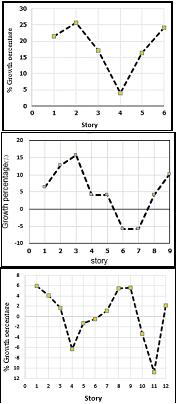Volume 11, Issue 1 (Vol. 11, No. 1 Spring 2017 2017)
2017, 11(1): 115-134 |
Back to browse issues page
Download citation:
BibTeX | RIS | EndNote | Medlars | ProCite | Reference Manager | RefWorks
Send citation to:



BibTeX | RIS | EndNote | Medlars | ProCite | Reference Manager | RefWorks
Send citation to:
mohammaditekantape J, nouri G, ghanbari A. Effect of Slope on Interstory Drift of Steel Moment Resistant Frames in Soft Soil . Journal of Engineering Geology 2017; 11 (1) :115-134
URL: http://jeg.khu.ac.ir/article-1-2507-en.html
URL: http://jeg.khu.ac.ir/article-1-2507-en.html
1- , m.tekantape@yahoo.com
Abstract: (7653 Views)
./files/site1/files/6Extended_Abstract.pdfExtended Abstract
(Paper pages 115-134)
Introduction
Different factors should be considered in investigating soil- structure interaction for which we can refer to underground layers material properties, site shape and topography and entry motion. It has been showed that seismic waves will be reflected and makes more strange seismic waves in comparison with the state of without slope. To investigate the topography effects the various assumptions such as considering the rigid and compliant bedrock, half space, stimulations with different frequencies, slopes with different angles, different heights of slopes, and soil type were evaluated. In this study topography effects on interstory drift of three structures with steel moment resistant frame system is considered, for this aim 6 combined model of soil- structure and topography is investigated. Three structures of 6, 9 and 12 story placed in near and far from of crest of a slope and 10 earthquake on bedrock has been applied to models. Interstory drift is considered as a criteria for investigating topography effect.
Material and Methods
This paper examines 3 planar steel moment resistant frame (SMRF) which have been previously designed by Karavasilis et al (2007) according to EC3 and EC8. These structures have 3 bays, and 6, 9, 12 stories. The length of each bay and the height of each story are 5 and 3 m, respectively. Furthermore, the amount of dead and live loads are considered in accordance with the current study (Minasidis et al 2014). The study frames were modeled in ABAQUS software in the form of two-dimensional (Figure 2). A36 steel is used in the models and the yield strength of steel is 235 MPa. Modeling of the behavior of steel was implemented using the yield criterion of VON MISES and taking into account the non-linear behavior of materials and Poisson's ratio of 0.3. A kinematic material hardening of 3% is assumed for the nonlinear elements and a Rayleigh damping of 5% is assumed for the first two modes of each frame.
In this study, a slope with α=20 is considered. The characteristics of the slope and the soil of the region are obtained by borehole in different point based on Ghanbari et al 2011 study.

Figure1. Growth percentage in average amount of interstory drift
The desired slope has a height of 30 m. The depth of the bedrock is considered equal to 60 m. The numerical analyses were performed with the Finite element method, for nonlinear soil with VS=238 m/s, Poisson’s ratio v=0.35 and mass density ρ=1800 kg/m3. Moreover, to estimate the distribution of response, 10 records located on the bedrock (shear wave velocity is more than 650 m/s) have been used. To reduce the near source effect records are selected in such a way that they have no pulse in velocity time history and Distance from source to site greater than 10 km considered
Result
Result showed that interstory drift of structures increases due to topography effects, but this increase varies for different structures and earthquakes. Growth percentage in average amount of interstory drift are 25, 15 and 6 percent for structures with 6, 9 and 12 story respectively. Also for structure 9 and 12 story, interstory drift was decrease in some stories.

(Paper pages 115-134)
Introduction
Different factors should be considered in investigating soil- structure interaction for which we can refer to underground layers material properties, site shape and topography and entry motion. It has been showed that seismic waves will be reflected and makes more strange seismic waves in comparison with the state of without slope. To investigate the topography effects the various assumptions such as considering the rigid and compliant bedrock, half space, stimulations with different frequencies, slopes with different angles, different heights of slopes, and soil type were evaluated. In this study topography effects on interstory drift of three structures with steel moment resistant frame system is considered, for this aim 6 combined model of soil- structure and topography is investigated. Three structures of 6, 9 and 12 story placed in near and far from of crest of a slope and 10 earthquake on bedrock has been applied to models. Interstory drift is considered as a criteria for investigating topography effect.
Material and Methods
This paper examines 3 planar steel moment resistant frame (SMRF) which have been previously designed by Karavasilis et al (2007) according to EC3 and EC8. These structures have 3 bays, and 6, 9, 12 stories. The length of each bay and the height of each story are 5 and 3 m, respectively. Furthermore, the amount of dead and live loads are considered in accordance with the current study (Minasidis et al 2014). The study frames were modeled in ABAQUS software in the form of two-dimensional (Figure 2). A36 steel is used in the models and the yield strength of steel is 235 MPa. Modeling of the behavior of steel was implemented using the yield criterion of VON MISES and taking into account the non-linear behavior of materials and Poisson's ratio of 0.3. A kinematic material hardening of 3% is assumed for the nonlinear elements and a Rayleigh damping of 5% is assumed for the first two modes of each frame.
In this study, a slope with α=20 is considered. The characteristics of the slope and the soil of the region are obtained by borehole in different point based on Ghanbari et al 2011 study.

Figure1. Growth percentage in average amount of interstory drift
The desired slope has a height of 30 m. The depth of the bedrock is considered equal to 60 m. The numerical analyses were performed with the Finite element method, for nonlinear soil with VS=238 m/s, Poisson’s ratio v=0.35 and mass density ρ=1800 kg/m3. Moreover, to estimate the distribution of response, 10 records located on the bedrock (shear wave velocity is more than 650 m/s) have been used. To reduce the near source effect records are selected in such a way that they have no pulse in velocity time history and Distance from source to site greater than 10 km considered
Result
Result showed that interstory drift of structures increases due to topography effects, but this increase varies for different structures and earthquakes. Growth percentage in average amount of interstory drift are 25, 15 and 6 percent for structures with 6, 9 and 12 story respectively. Also for structure 9 and 12 story, interstory drift was decrease in some stories.
6Extended Abstract
Type of Study: Case-Study |
Subject:
Geotecnic
Received: 2016/01/25 | Accepted: 2016/05/29 | Published: 2017/02/25
Received: 2016/01/25 | Accepted: 2016/05/29 | Published: 2017/02/25
| Rights and permissions | |
 |
This work is licensed under a Creative Commons Attribution-NonCommercial 4.0 International License. |






